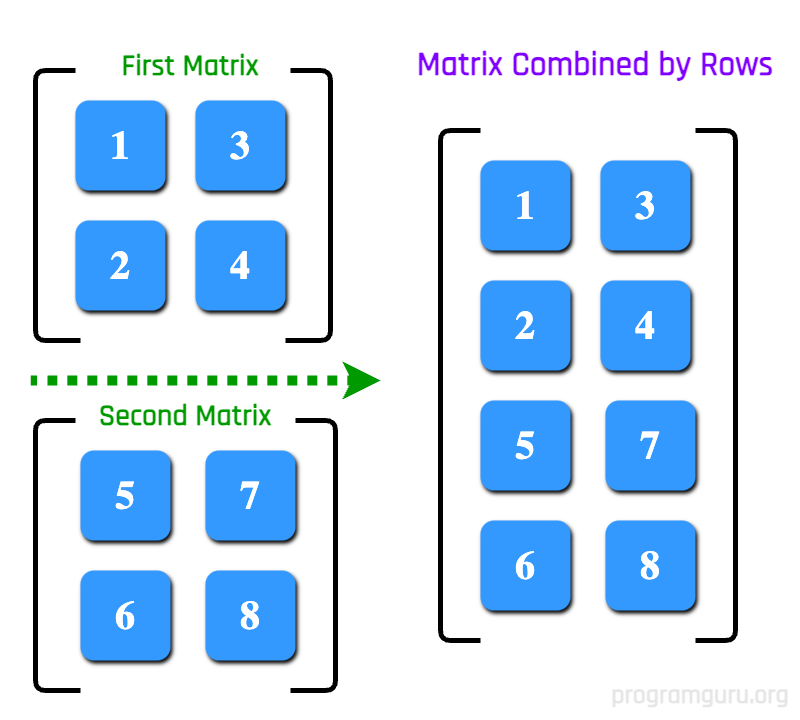To combine matrices by rows in R, you can use the rbind() function. This function takes two or more matrices as arguments and combines them by rows, resulting in a new matrix where the rows of the input matrices are concatenated one after the other.

In this example,
matrix1 with the values from 1 to 6 arranged in 2 rows and 3 columns using the matrix() function. The matrix() function takes a vector of values and the arguments nrow and ncol to specify the number of rows and columns respectively.matrix2 with the values from 7 to 12 arranged in 2 rows and 3 columns using the matrix() function.rbind() function to combine matrix1 and matrix2 by rows. This function concatenates the rows of matrix1 and matrix2 one after the other, resulting in a new matrix named combined_matrix.rbind() function returns a new matrix with the combined rows of the input matrices.combined_matrix to standard output to see the combined result.matrix1 <- matrix(1:6, nrow = 2, ncol = 3)
matrix2 <- matrix(7:12, nrow = 2, ncol = 3)
combined_matrix <- rbind(matrix1, matrix2)
print(combined_matrix)[,1] [,2] [,3] [1,] 1 3 5 [2,] 2 4 6 [3,] 7 9 11 [4,] 8 10 12
In this example,
matrix1 with the values from 1 to 4 arranged in 2 rows and 2 columns using the matrix() function. The matrix() function takes a vector of values and the arguments nrow and ncol to specify the number of rows and columns respectively.matrix2 with the values from 5 to 8 arranged in 2 rows and 2 columns using the matrix() function.matrix3 with the values from 9 to 12 arranged in 2 rows and 2 columns using the matrix() function.rbind() function to combine matrix1, matrix2, and matrix3 by rows. This function concatenates the rows of the three matrices one after the other, resulting in a new matrix named combined_matrix.rbind() function returns a new matrix with the combined rows of the input matrices.combined_matrix to standard output to see the combined result.matrix1 <- matrix(1:4, nrow = 2, ncol = 2)
matrix2 <- matrix(5:8, nrow = 2, ncol = 2)
matrix3 <- matrix(9:12, nrow = 2, ncol = 2)
combined_matrix <- rbind(matrix1, matrix2, matrix3)
print(combined_matrix)[,1] [,2] [1,] 1 3 [2,] 2 4 [3,] 5 7 [4,] 6 8 [5,] 9 11 [6,] 10 12
In this example,
matrix1 with the values from 1 to 6 arranged in 2 rows and 3 columns using the matrix() function. The matrix() function takes a vector of values and the arguments nrow and ncol to specify the number of rows and columns respectively.matrix2 with the values from 7 to 8 arranged in 1 row and 3 columns using the matrix() function.rbind() function to combine matrix1 and matrix2 by rows. This function concatenates the rows of matrix1 and matrix2 one after the other, resulting in a new matrix named combined_matrix.rbind() function returns a new matrix with the combined rows of the input matrices.combined_matrix to standard output to see the combined result.matrix1 <- matrix(1:6, nrow = 2, ncol = 3)
matrix2 <- matrix(7:9, nrow = 1, ncol = 3)
combined_matrix <- rbind(matrix1, matrix2)
print(combined_matrix)[,1] [,2] [,3] [1,] 1 3 5 [2,] 2 4 6 [3,] 7 8 9
In this tutorial, we learned How to Combine Matrices by Rows in R language with well detailed examples.